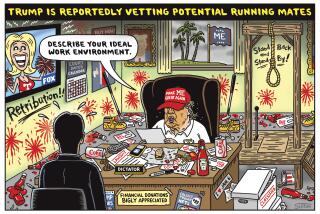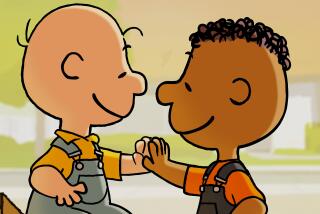Palm-of-the-hand comics ... for a cigarette machine
How much do I love Andy Brown and Joe Ollmann’s “Milo & Sam” (Conundrum: unpaged, $2 paper)? It’s the kind of project that reframes ambition, telling a nuanced story almost entirely between the lines.
A palm-sized comic, about the size of a pack of cigarettes (more on this in a moment), it features a single black-and-white frame per page. The effect is to draw us into the intimacy of the narrative, which is about two dads and their young sons on an outing to the country, a pastoral that turns tense when one of the kids eats a (potentionally poisonous) mushroom.
Ollmann, of course, specializes in this sort of stuff; his graphic novels “Mid-Life” and “Science Fiction” make epic art out of the mundane. Here, though, he and Brown (who founded Conundrum, the Montréal-based comics press that publishes Ollmann, among many others) have effectively upped (or downed) the stakes.
“I conceived of a four panel daily comic strip,” Brown writes in a brief afterword, “which would harken back to the old newspaper strips of the 20s-30s, especially Frank King’s ‘Gasoline Alley.’ Since my son Milo was two at the time and he played a lot with his best buddy Sam [Ollmann’s son] … I logically thought to use this wealth of material for the project. In the end we collaborated on five strips, each one basically a gag. … What I hoped to create was a modern retelling of these old strips, retaining the tone, nostalgic but vulnerable, which I believe captures the anxieties and joys of being a new father.”
“Milo & Sam” pulls this off, while also pushing, effectively, into new territory. Partly, this has to do with the parallel relationships, between the fathers on the one hand and the sons on the other, and partly with the stripped down dynamic of the storytelling. Here, nothing happens, really, but at the same time, everything does.
This is only heightened by the presence, in the latter frames, of Brown’s wife Meg Sircom, who died of cancer in 2011 at age 43. The book is dedicated to her memory, but her appearance at the hospital, where the two dads have gone after the mushroom eating incident, makes her (and her loss) vivid to us in a compelling way.
Then, there is the form of the book, a true palm-of-the-hand story, designed to be sold in Louis Rastelli’s Distroboto machine. This is a cigarette vending machine, reconfigured to sell small books and art objects at various events and exhibitions; as Brown writes, “Milo & Sam” grew out of a call by Rastelli and a curator named Meredith Caruthers for “a number of Montréal artists to create maps of the city in a unique way.”
That this is what Brown and Ollmann came up with suggests the variety of ways we map our existence, through memory and friendship as well as cartography. Here, we see what “Milo & Sam” has to offer: a kind of atlas, in miniature, of two fathers with their children, “nostalgic but vulnerable,” on a day before the world changed.
More to Read
Sign up for our Book Club newsletter
Get the latest news, events and more from the Los Angeles Times Book Club, and help us get L.A. reading and talking.
You may occasionally receive promotional content from the Los Angeles Times.







